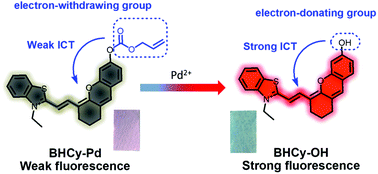A highly sensitive sensor for colorimetric detection of palladium(ii) in lysosomes and its applications†
Abstract
Considering the scarcity of palladium ion probes with subcellular organelle targeting, especially probes with near-infrared (NIR) emission wavelength fluorophores, our group has been working to overcome this problem and looking forward to providing potential practical tools for exploring the toxicity of palladium ions at the subcellular level. In this paper, a novel colorimetric and NIR fluorescent probe, BHCy-Pd, for the specific detection of palladium ions (Pd2+) in lysosomes via an internal charge-transfer (ICT) mechanism was designed and synthesized. As expected, BHCy-Pd exhibited a rapid, selective, and sensitive response for palladium with an ultralow limit of detection at 5.9 nM, accompanied by a distinct color change from purple to blue. Furthermore, BHCy-Pd can be made into a simple test strip for rapid and easy detection of Pd2+ in practical applications. Importantly, BHCy-Pd is capable of specific distribution in lysosomes, and thus can detect Pd2+ in real-time, thereby providing a potential tool for studying the cytotoxicity of Pd2+ ions at the subcellular level.



 Please wait while we load your content...
Please wait while we load your content...